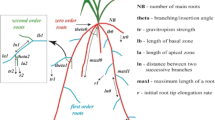Abstract
Root length density (RLD) is an important determinant of crop water and nutrient acquisition, but is difficult to measure in the field. On a soil profile, in-situ counts of root impacts per unit surface on soil profiles (NI) can be used to calculate RLD if crop-specific parameters for preferential root orientation (anisotropy) are known. An improved method for field determinations of RLD was developed and validated for maize at sites in Côte d'Ivoire and Burkina Faso. Root anisotropy was measured with cubes of undisturbed soil with 0.1 m sidelength, based on NI observed on three planes oriented perpendicularly to each other. RLD was also measured for the enclosed volume. Repetition of such measurements enabled estimation of the robustness across sites of empirical and geometric models for the relationship between RLD and NI:RLD = NI CO, with CO being the coefficient of root orientation, theoretically equals 2 for an isotropic distribution. Root systems were found to be nearly isotropic, except near the root front (0.3 to 0.5 m), where roots had a preferentially orthotropic orientation. Measured RLD was generally about 50% larger than RLD calculated from observed NI and CO, indicating that at least one of the measurement techniques had a systematic error. The ratio between measured and calculated RLD (CE), which ranged from 0.8 to 2, increased with the age of the plants and decreased with soil depth. CE was therefore introduced as an additional coefficient, resulting in RLD = NI CO CE. The empirical value for CO CE was between 2 and 5. The empirical coefficients CO and CE were the same for the sites in Cote d'Ivoire (oxisol with an iron pan at 0.6 to 0.9 m) and Burkina Faso (alfisol with an iron pan at 0.4 to 0.8 m). The model was validated with independent data sets at both sites, and gave satisfactory predictions of RLD on the basis of NI obtained from single soil planes, which can be easily measured in the field.
Similar content being viewed by others
References
Barber S A 1971 Effect of soil tillage practice on corn (Zea mays L.) root distribution and morphology. Agron. J. 63, 724–726.
Bland W L and Dugas W 1988 Root length density from minirhizotron observations. Agron. J. 80, 271–275.
Bohm W 1976 In situ estimation of root length at natural soil profiles. J. Agric. Camb. 87, 365–368.
Box J E 1996 Modern methods for root investigations. In Plant Roots the Hidden Half, 2nd ed. Eds Y Waisel et al. pp 193–237. M. Dekker Publishers, New York.
Bragg P L, Govi G and Cannel R Q 1983 A comparison of methods including angled and vertical minirhizotrons, for studying root growth and distribution in a spring oat crop. Plant Soil 73, 435–440.
Chopart J L 1985 Développement racinaire de quelques espèces annuelles cultivées en Afrique de l'ouest et résistance à la sécheresse. In La sécheresse en zone intertropicale, pour une lutte intégrée. pp 145–154. CILF edit. Paris.
Drew M C and Saker L R 1980 Assessment of a rapid method, using soil cores, for estimating the amount and distribution of crop roots in the field. Plant Soil 55, 297–295.
Gardner W R 1960 Dynamic aspects of water availability to plants. Soil Science 89, 63–73.
Gardner W R 1964 Relation of root distribution to water uptake and availability. Agron. J. 56, 41–45.
Gijsman A J, Floris J, Van Noordwijk M and Brouwer G 1991 An inflatable minirhizotron system for root observations with improved soil/tube contact. Plant Soil 134, 261–269.
Lang A R G and Melhuish FM 1970 Length and diameters of plants root in non random populations by analysis of plane surface. Biometrics 26, 42–431.
Majdi H, Smucker A JMand Person H 1992 A comparison between minirhizotron and monolith sampling methods for measuring root growth of maize (Zea mays L.) Plant Soil 147, 127–134.
Marriot F 1972 Buffon's problem for non-random distribution. Biometrics 28, 621–624.
Melhuish F M and Lang A R G 1968 Quantitative studies of root in soil. I: Length and diameters of cotton roots in a clay-loam soil by analysis of surface-ground blocks of resin-impregnated soil. Soil Sci. 106, 16–22.
Meyer W S and Barrs H D 1985 Non-destructive measurements of wheat root in large undisturbed and repacked clay soil cores. Plant Soil 85, 237–245.
Newman J 1966 A method of estimating the total length of root in a sample. J. App. Ecol. 3, 139–145.
Tardieu Mand Manichon H 1986 Caractérisation en tant que capteur d'eau de l'enracinement du maïs en parcelle cultivée. II Une méthode d'étude de la répartition verticale et horizontale des racines. Agronomie 6, 415–425.
Taylor H M and Bohm W 1976 Use of acrilyc plastic as rhizotron windows. Agron J. 68, 693–694.
Tennant D 1975 A test of a modified line intersect method of estimating root length. J. Ecol. 63, 955–1001.
Upchurch D R 1985 Relationship between observations in minirhizotrons and true root length density. Ph.D. Thesis, Texas Tech. Univ., Lubbock (Diss. Abstr. 85–28594).
Upchurch D R and Ritchie J T 1983 Root observations using a video recording system in mini-rhizotrons. Agron. J. 75, 1009–1015.
Van Noordwijk M 1987 Methods for quantification of root distribution pattern and root dynamics in the field. In 20th Colloq. Int. Potash Institute, Bern, pp. 247–265. Int. Potash Inst. Publishers, Berne.
Van Noordwijk M, Kooistra MJ, Boone F R, Veen BW and Schoonderbeek D 1992 Root-soil contact of maize, as measured by a thin-section technique. 1: Validity of the method. Plant soil 139, 109–118.
Vos J and Groenwold J 1983 Estimation of root densities by observation tubes and endoscopes. Plant Soil, 74, 295–300.
Author information
Authors and Affiliations
Rights and permissions
About this article
Cite this article
Chopart, J.L., Siband, P. Development and validation of a model to describe root length density of maize from root counts on soil profiles. Plant and Soil 214, 61–74 (1999). https://doi.org/10.1023/A:1004658918388
Issue Date:
DOI: https://doi.org/10.1023/A:1004658918388




